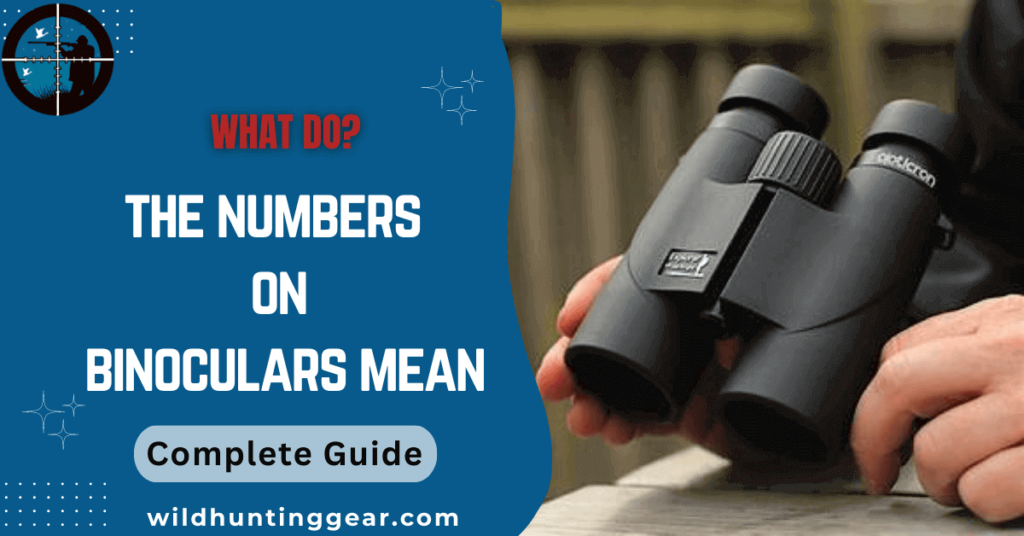In the world of optics, binoculars have served as invaluable tools for magnifying our view of the world. Their compact design and ability to bring distant objects closer have made them indispensable for various activities, from nature observation to stargazing.
If you’ve ever closely examined a pair of binoculars, you might have noticed a series of numbers imprinted on them. These numbers, often accompanied by other symbols, serve a specific purpose and hold valuable information about the binoculars’ capabilities and specifications.
In this blog post, we enter a journey to decode the secret meaning behind the numbers on binoculars. Join us as we unravel the secrets behind these numeric codes, revealing how they can enhance our understanding and appreciation of these optical marvels.
What do the numbers on binoculars mean?

The numbers on binoculars are used to denote the magnification power, field of view and size of the objective lenses. Typically, the numbers are separated by an “x”, a slash (/) or a hyphen (-).
The first number is usually the magnification power while the second number is often associated with either the size of the objective lenses or the width of the field of view.
For instance, a 10×50 binocular would have a magnification power of 10 and an objective lens diameter of 50mm. On the other hand, a 7-20×40 would possess a variable magnification power ranging from 7 to 20 times and an objective lens size of 40mm.
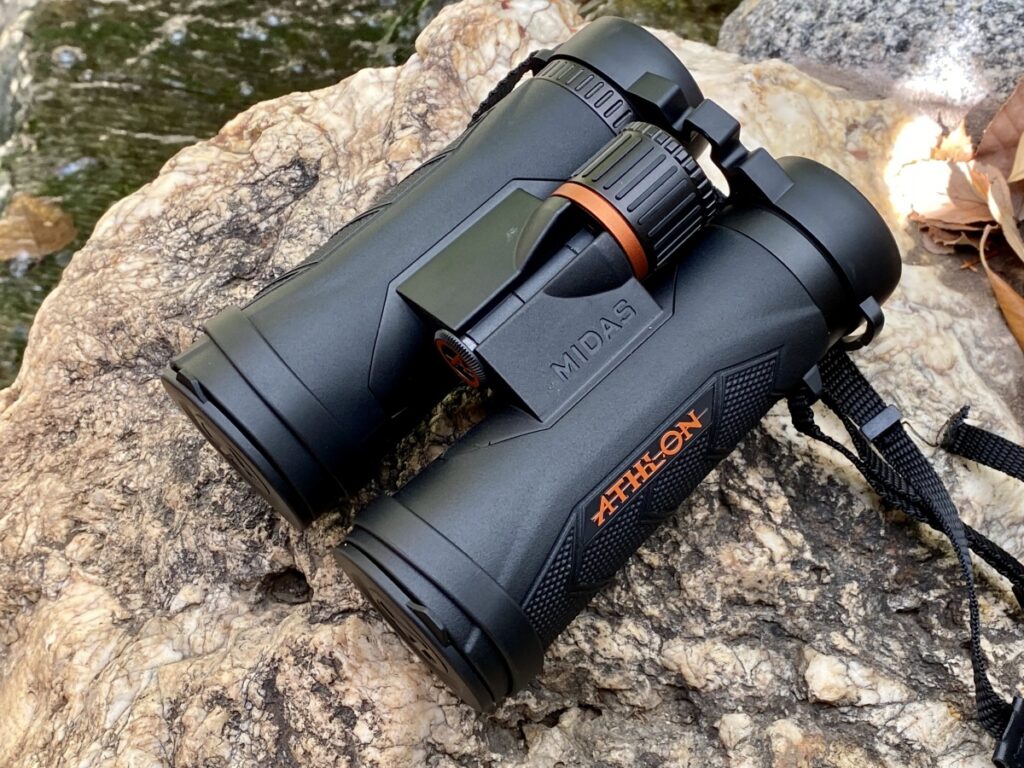
The numbers on binoculars can also denote the size and type of eyepiece used. The first number typically indicates the size of the eye relief (distance between your eyes and the binoculars), while the second letter denotes whether it is a twist-up model or not.
For instance, a 7/14×50 would have an eye relief distance of 7mm and feature twist-up eyepieces.
Understanding binocular terminology
Before we explore the numbers on binoculars, it’s important to first understand some of the terminology associated with these optics. The large number inscribed on the front of most binoculars is known as their magnification power, often abbreviated as “x”.
This indicates by what factor objects will appear larger when viewed through a pair of binoculars. For example, a pair of 10x binoculars will make an object appear 10 times larger than it does to the naked eye.
The second number inscribed on binoculars is known as their objective lenses’ diameter, measured in millimetres (mm). This indicates how wide the front lens is and thus determines how much light enters the binoculars. A wider lens is better for observing in low- conditions, such as at night.

Finally, the third number inscribed on binoculars is known as their exit pupil. This indicates the diameter of the light beam that exits through the eyepiece and determines how much of the image can be seen at a given time. Generally speaking, larger exit pupils provide a brighter and clearer image.
With this knowledge in mind, let’s now take a closer look at the numbers on binoculars to see what they can tell us about their capabilities and specifications.
Deep Dive into Binocular Numbers
- Magnification power and field of view:
The magnification power of a binocular is also an important factor to consider. Binoculars can magnify an object from 7x up to 50x (or more). Higher magnifications allow you to see distant objects in greater detail but they also tend to have narrower fields of view. For most applications, 8-10x magnification is usually the best choice.
The field of view (FOV) is measured in feet and tells you how wide an area you can see at a set distance. For example, if the binoculars have a FOV of 1000 feet at 1000 yards, then when looking through the binoculars at an object 1000 yards away, you would be able to see an area that was 1000 feet wide. Generally, more powerful binoculars have a narrower FOV and vice versa.
To ensure you’re getting the best experience with your binoculars, it’s important to make sure you’re choosing one with the right magnification power and field of view for your needs. Whether you’re using them for birdwatching or hunting, selecting the right magnification can make a huge difference in the quality of your viewing experience.
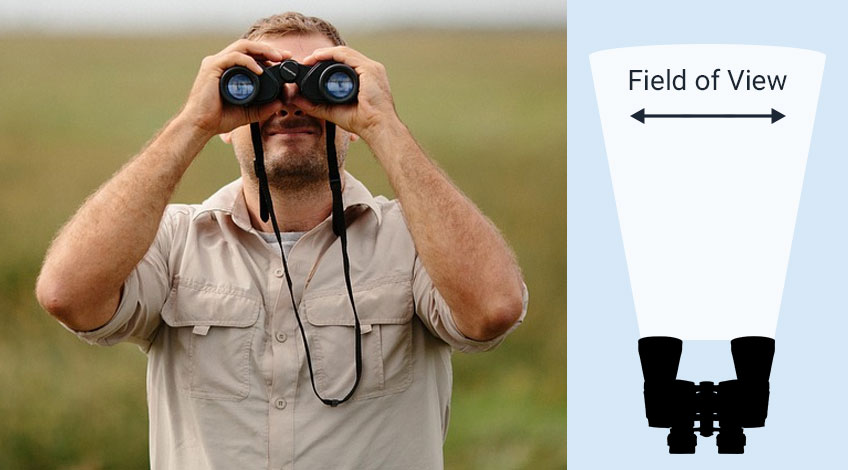
- Objective lens Size and eye relief distance:
The second and third numbers on binoculars typically denote the size of the objective lens and eye relief distance, respectively. The larger number is usually the diameter of the objective lens (in millimetres), which determines how much light enters a pair of binoculars. A wider lens is better for viewing in low-light conditions.
On the other hand, the smaller number typically indicates the eye relief distance (in millimetres) between your eyes and the binoculars. Generally speaking, longer eye relief distances offer more comfort for extended viewing periods. Additionally, a twist-up eyepiece is typically denoted by a letter after the eye relief distance.
- Exit pupil size:
Some binoculars also feature a third number that indicates the size of the exit pupil. This number is calculated by dividing the diameter of the objective lens (in millimetres) by the magnification power. Generally, binoculars with an exit pupil greater than 7mm are considered to be good for low-light conditions.
Understanding other related numbers and terms
Beyond the numbers on binoculars, there are several other related terms and designations used to describe their capabilities. For instance, a binocular’s “angular field of view” indicates how wide an angle you can observe with a given pair of binoculars. This number is typically expressed in degrees (°) and ranges from 5° to 8° for most binoculars.
Binoculars are also often marked with the term “BAK-4 prism” or “Phase Coating”. BAK-4 prisms refer to a particular type of optical glass, while phase coating is an additional layer of protection applied to the objective lenses that help reduce chromatic aberration and maximize light transmission for a clearer image.
Lastly, binoculars are sometimes marked with the term “ED” or “HD”. ED stands for Extra-low Dispersion glass and is used to reduce chromatic aberration and improve image clarity. HD refers to High-Definition glass and provides an even higher level of detail than ED glass.
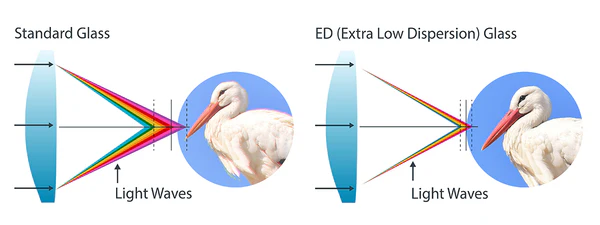
By understanding all of these terms and designations, you can get a better sense of how well a given pair of binoculars will perform in various conditions and for different types of activities. However, it’s important to remember that the numbers on binoculars are only part of the story: there is no substitute for actually testing out a pair yourself to see if they suit your needs!
Objective lens diameter
The size of a binocular’s objective lens is one of the most important factors to consider when selecting a pair. The larger the diameter of the objective lens, the more light it can gather and thus the brighter and clearer an image will appear. A larger objective lens is also typically preferable for observing in low-light conditions, such as at night.
When choosing a pair of binoculars, it’s important to consider the intended use and size of the binoculars. For instance, if you plan on taking your binoculars out for wildlife observation, cameras with an objective lens diameter in the 40-50mm range are usually recommended.
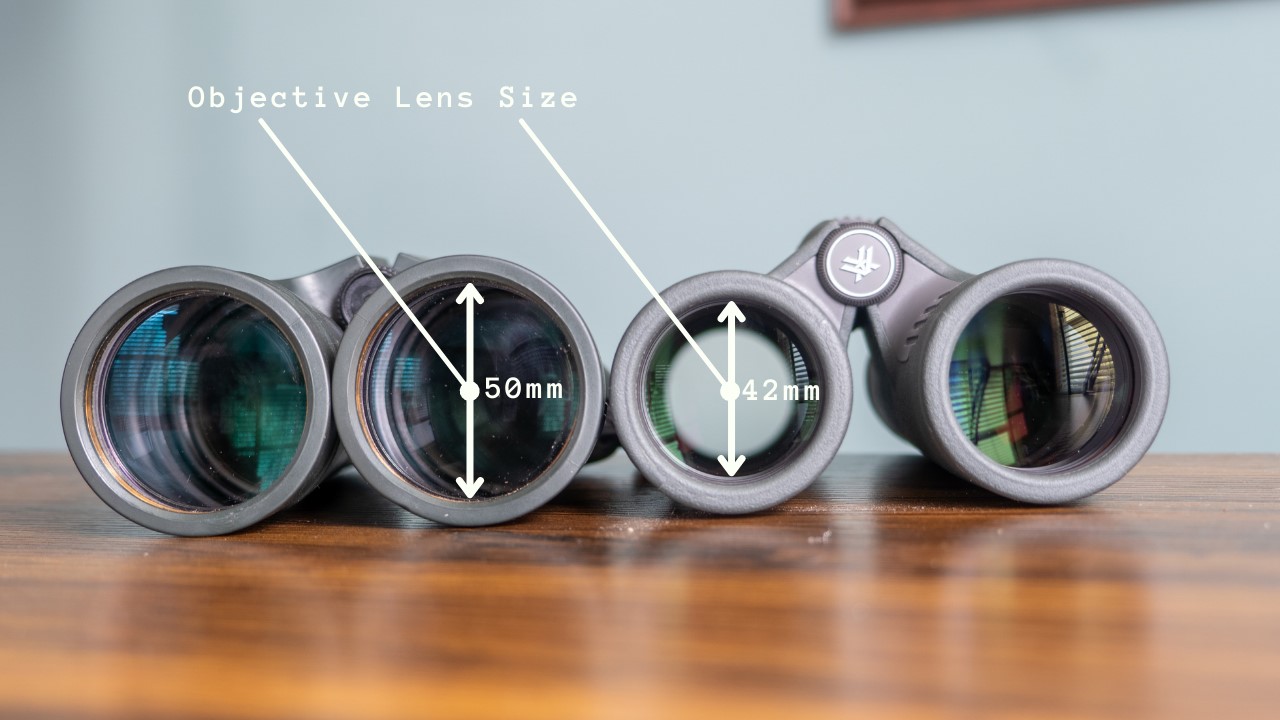
On the other hand, if you’re looking for something more compact and portable, binoculars in the 20-25mm range are usually suitable.
Generally speaking, larger objective lenses offer superior image quality and brightness but can also be more cumbersome to carry around. Therefore, it’s important to find a balance between size and performance that is right for you.
Importance of objective lens diameter
The size of a binocular’s objective lens plays an integral role in determining the quality of the images that it produces. Larger objective lenses can gather more light and produce brighter and clearer images than smaller ones, making them ideal for use in low-light conditions such as at night.
Additionally, larger lenses are capable of gathering more detail from far-off objects for a better overall viewing experience. The brighter and clearer images that larger objective lenses produce are also beneficial for bird watching, stargazing and other wildlife observation activities.
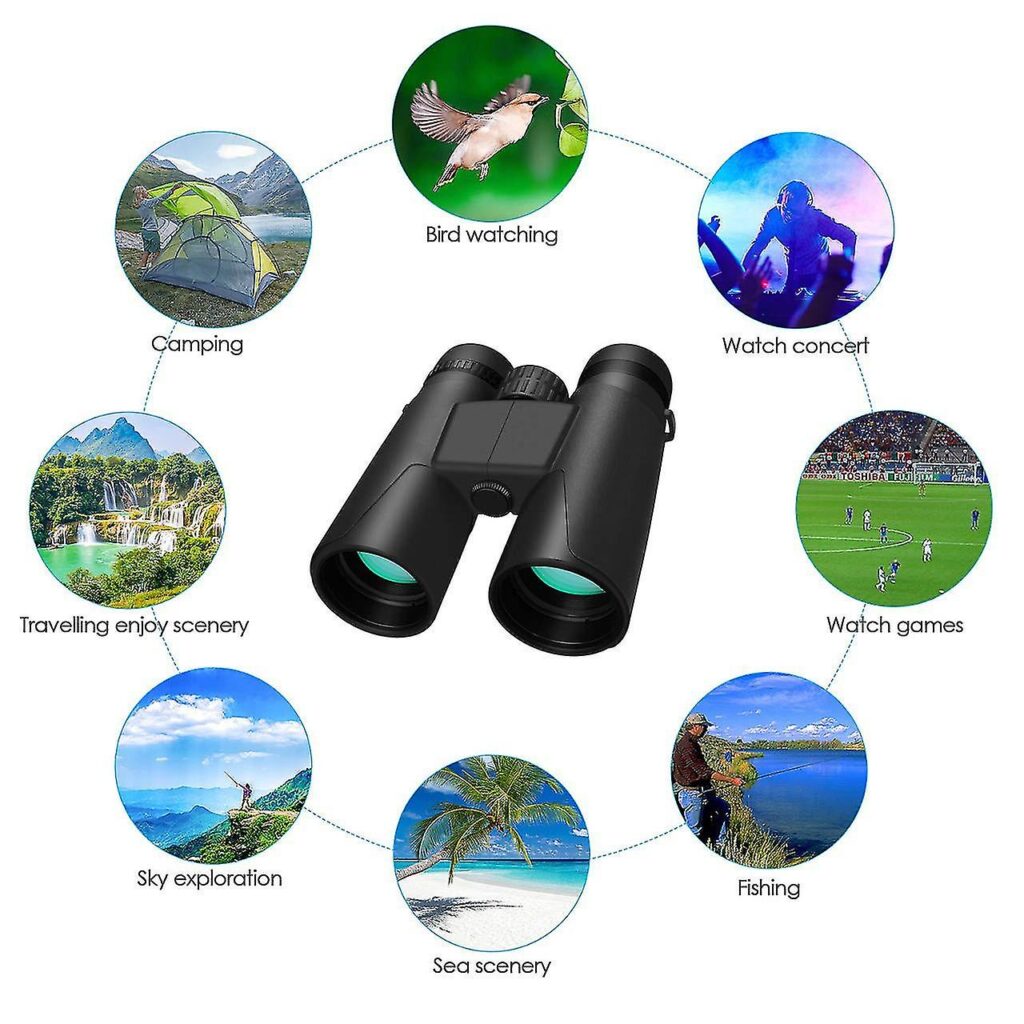
Furthermore, because they require more light to function effectively, larger objective lenses tend to be better suited for long-distance viewing than smaller ones.
In addition to the impact on image quality, larger objective lenses also require more physical space. Therefore, it’s important to consider the size of the binoculars and their intended use when selecting a pair.
If you plan on carrying your binoculars around frequently, then a smaller pair with a smaller objective lens may be preferable. On the other hand, if you prefer superior image quality over portability, then a larger pair with a larger objective lens may be the better choice.
Regardless of which size you choose, understanding the importance of objective lens diameter will help you find a pair of binoculars that is best suited to your needs.
Choosing the appropriate objective lens diameter
When selecting a pair of binoculars, there are several factors to consider in addition to the objective lens diameter. For instance, your intended use should be taken into account when choosing the size of your binoculars.
If you plan on using them for wildlife observation, then a larger pair with a larger objective lens is typically preferable. On the other hand, if you need something more portable and lightweight, then a smaller pair may be better suited to your needs.
Recommended lens sizes for different scenarios
In terms of selecting an appropriate objective lens diameter, the following recommendations are generally applicable to most scenarios:
- Wildlife Observation: 40-50mm
- Astronomy and Stargazing: 50-80mm
- Hunting and Bird Watching: 30-40mm
- Indoor Events/Sports: 25-35mm
These numbers are only guidelines, however; it is ultimately up to you to determine what size will work best for your needs. Keep in mind that larger objective lenses tend to provide brighter and clearer images but are also more cumbersome to carry around.
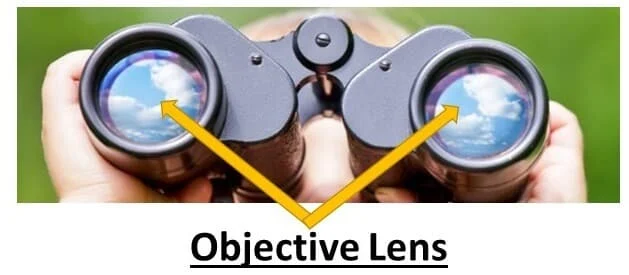
Ultimately, by understanding the importance of objective lens diameter and considering your intended use, you can find a pair of binoculars that best suit your needs.
Final Thoughts
It is clear that binoculars also referred to as field glasses and often used for bird watching, all come with numbers imprinted on them. This number identifies a few different things about the binoculars in question.
The first two numbers represent the magnification power of the binoculars, where the first is typically an objective lens such as 8 or 10 and the smaller one is typically a 3 or 5. The next two digits will tell you whether these are wide-angle lenses in addition to their level of specs like TN coatings, ED glass and so on.
Finally, the last two digits describe what sort of eyecups these have – if they’re fold-down/twist-up style and if they can also be adjusted for
inter pupillary distance as well. In short, while these numbers may seem confusing at first glance, understanding them can help you find quality binoculars that best suit your specific needs.
